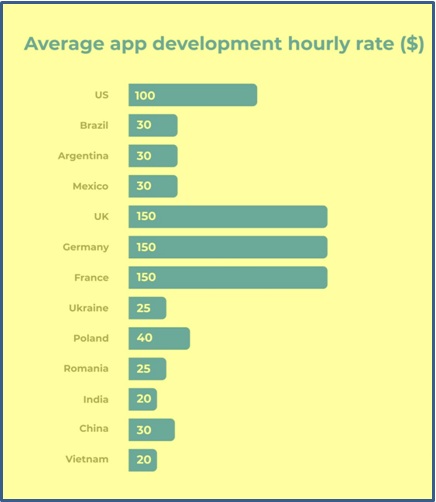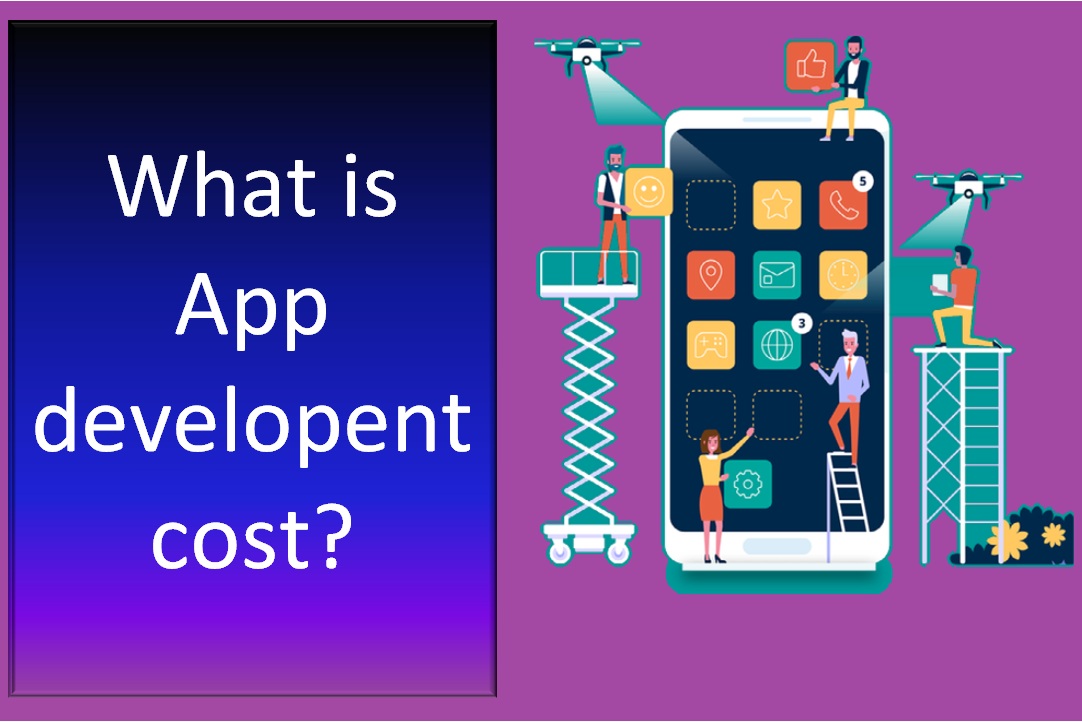App development cost depends on different factors and what type of app your developing. Below are the points
- Which type of app are you developing? Make plan about the app’s core functionality and purpose. This will help you understand its complexity.
- Which platforms and devices will it support? Are you building for Android,iOS, or both? And which devices do you want to cover? For example, will it run on the iPhone 15 Pro Max, Samsung Galaxy S10 Plus, or maybe even tablets?
- Do you need a developing team?If your project requires specific expertise, like native app development for iOS or Android, you might need experts. If you’re aiming for a faster launch, cross-platform development might be a better fit.
- Will your app need third-party integrations? Think about if your app will connect to tools like HubSpot, Zapier, Salesforce, or any other platforms. These integrations can add functionality but might also affect the budget.
- Will your app use smartphone features? Are you planning to include features like GPS, NFC, AR, or motion co-processors? Using built-in hardware can add exciting functionality but may also impact development time and costs.
- What’s the maintenance plan? Launching your app is just the beginning. You’ll need ongoing updates to fix bugs and add new features. At Intellectsoft, we provide end-to-end support, so your app stays fresh and functional long after it’s live.
- What’s your timeline? How soon do you need to launch? Knowing your deadline will help you and your development partner set clear priorities and work efficiently.
- What’s your budget? Your budget will guide the development approach—whether it’s native or cross-platform. Keep in mind, native apps usually cost more but can offer higher performance for specific platforms.
- How much support do you need? Are you just looking for help with the Discovery and Development phases to build an MVP? Or do you need full-cycle support for a large, enterprise-level app?
- How important is UX/UI design? A great app needs great design. Decide how much effort you want to put into creating a user-friendly and visually appealing experience.
Let’s Talk Hours and Rates

App Complexity Matters
App complexity heavily impacts the cost of mobile app development. The complexity of an app can be grouped into three types: simple, medium, and complex.
- Simple Apps: These apps have a basic set of features and functionalities, such as user profiles, navigation, and a simple user interface. They are straightforward to develop and typically take around 2-3 months to complete. For example, basic fitness trackers or calculators.
- Medium Apps: Medium complexity apps are more challenging to create as they contain more sophisticated features, interactive elements, and a larger amount of content. Such as social networking apps, e-commerce platforms, and online learning tools. The development time for medium apps is usually 4-6 months.
- Complex Apps: Complex apps come with advanced features, responsive design, extensive navigation, third-party integrations, and a high level of complexity. Some of these are custom-built EHR/EMR systems for healthcare organizations or large-scale enterprise solutions. Developing a complex app can take anywhere from 6 to 12 months.
App Development Cost Strategy
- First step (10–15%)
Focused on requirement analysis and project scoping to lay the groundwork for development. - Design Step (20–25%)
Here, your tech partner brings the visual side to life with UI/UX design, wireframes, prototypes, and mockups, crafting an app that’s both functional and attractive. - Development (40–55%)
Unsurprisingly, the largest share of the budget is allocated to coding, backend infrastructure, and feature integration, bringing the designs to life as a fully functional app. - Testing (15–20%)
This important stage involves rigorous QA testing, including unit, system, and regression testing, to identify and fix bugs for smooth app performance. - Deployment (5–10%).
Focuses on launching the app in stores, ensuring post-launch maintenance, updates, and ongoing functionality.
What are the hidden costs in app development?
1. After-Launch Maintenance
The app maintenance cost doesn’t end even the app is launched. New updates, bug fixes, and compatibility adjustments (e.g., for new OS versions) are essential to keep the app running smoothly.
2. App Store Fees
Publishing your app on platforms like the Apple App Store and Google Play comes with fees.
3. Third-Party Services and Integrations
If your app uses third-party APIs or services (e.g., payment gateways, geolocation, analytics tools), those come with costs. Stripe Gateway for payments, Google Maps for geolocation.
4. Cloud and Hosting Services
Apps that rely on cloud storage or backend services require ongoing hosting costs. AWS, Google Cloud, Firebase.
5. Security and Compliance
Be sure your app is secure and compliant with regulations like GDPR or HIPAA – it can be a hidden expense. Cost depends on the level of security and industry requirements.
6. Scaling and Performance Optimization
As your user base grows, you’ll need to scale your infrastructure, optimize performance, and handle higher traffic, all of which contribute to app maintenance costs. Consider these factors as well. Adding servers, load balancers, or optimizing databases.
Trends Impacting Development Costs
- Chatboats& Chat Features
Chatbots are game-changers for customer engagement and 24/7 support. But integrating AI and natural language processing (NLP) isn’t always quick or cheap. It’s an investment that pays off in better user experiences.
- Multi-Factor Authentication (MFA)
MFA is a must-have for strong security these days. From biometrics to token-based logins, it boosts trust and compliance. Yes, it adds to costs, but your users (and regulators) will thank you.
- Targeted Push Notifications
Personalized push notifications keep users coming back. But making them truly effective takes advanced data segmentation and analytics integration, which can complicate and stretch the budget.
- Augmented Reality (AR) & Virtual Reality (VR)
AR and VR bring next-level experiences to retail, gaming, and more. They also need specialized tools and expertise, making them pricier to implement.
- Artificial intelligence & Machine Learning
AI is revolutionizing development. It handles repetitive tasks, optimizes processes, and delivers insights that wow. But getting AI right takes effort—clean data, training models, and expert integration all add up.
- Mobile Cloud Computing
Cloud tech enables seamless scaling—no huge upfront costs, just flexibility when you need it. Still, integrating and managing cloud solutions can add complexity to your project.
- Data analytics
Data is gold if you know how to use it. Analytics turns raw numbers into actionable insights. But it needs clean, well-prepped data from skilled engineers to work its magic.
How to Prepare for App Development Cost Estimation
1. Define Your Goals and Scope
For mobile apps, it’s important to define:
- The app’s primary purpose and type (e.g., e-commerce, social networking, or healthcare apps).
- Core features like user authentication, push notifications, GPS tracking, and payment integration.
- Platforms: Will the app be built for iOS, Android, or both?
2. Understand Development Costs
In mobile app development, these factors are relevant:
- Frameworks: Using cross-platform tools like React Native or Flutter is often more cost-effective than building separate native apps.
- Team Expertise: The app’s complexity, including features like real-time data processing or AR/VR, may require senior developers, whereas simpler apps might rely on a smaller team or junior developers.
3. Account for Infrastructure Expenses
Apps rely heavily on backend infrastructure:
- Cloud Solutions: Scalable cloud services like AWS or Firebase are often the go-to for mobile apps. They enable efficient data storage and real-time updates.
- Scaling Needs: As app downloads and active users grow, you’ll need robust backend support, including databases, APIs, and server load management.
4. Prioritize Security
Mobile apps often handle sensitive data (e.g., user profiles, payment details). Key considerations to have in mind:
- Implementing secure APIs for data transfer.
- Adding encryption to protect user data on both the device and the server.
- Complying with mobile-specific regulations like Apple’s App Store guidelines or Android’s Play Store policies.
5. Plan for Long-Term Costs
Mobile apps require consistent updates for:
- Adapting to new operating system versions (iOS and Android release updates annually).
- Bug fixes and performance enhancements based on user feedback.
- Adding new features as user expectations grow.
